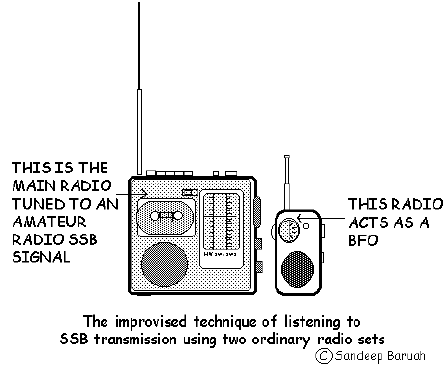Can I listen to the ham radio transmissions in my ordinary radio receiver set?
![]()
Can I listen to the ham
radio transmissions in my ordinary radio receiver set?
It is illegal to
listen to any type of radio transmissions which are not intended for you. Ham radio is
also a communication service recognized by the Governments all over the world. Obviously
you will require a Short Wave Listeners licence (click here for details)
to listen to the ham radio transmissions! However, nobody can stop you in listening to the
hams even if you don't possess a ham radio licence or short wave listener's licence! I am
telling you the legal aspect. But there is more you have to learn about the
technical aspects of the the hobby if you are seriously interested in listening to ham
radio transmissions.
The radio sets available in the market for general public are designed to receive
Amplitude Modulated (AM) or Frequency Modulated (FM) broadcasts only. But the ham radio
operators use a very efficient mode of transmission called Single Side Band (SSB)
transmission. The power of a ham radio station is also very low ( usually not more than
100 watts) in comparison to the broadcast station (which use power in the kilowatts
range). In fact many of the broadcast band radio receivers available in the market also
covers some of the frequencies which are allotted to the ham radio stations. A 4 band
radio set (inclusive of the Medium Wave band) can be expected to cover some popular ham
radio frequencies like 7 to 7.1 MHz (i.e. 7000 to 7100 kHz),
14 to 14.350 MHz (i.e. 14,000 to 14,350 kHz) and 21 to 21.450 MHz
(i.e. 21,000 to 21,450 kHz). This kind of receiver can be improvised to receive
ham radio transmissions with very little effort.
First, we will need an outdoor aerial. Because, these radio sets are not sensitive to receive low power transmissions. Majority of the hams use power below 100 watts (a broadscast station may use 4000 or 5000 watts of power!). A novice ham radio operator may be found to be operating with a power as low as 0.5 watt!
Ham radio conversation if heard on an ordinary radio set sounds like the 'Duck quacking'. There is no intelligibility in the audio. As already mentioned, our ordinary radio sets are meant to receive AM signals only and not to receive SSB signals-a separate unit is required at the 'Detector' stage of the AM receiver, which is nothing but a stable 'Frequency Generator' (RF Oscillator), called the 'Beat Frequency Oscillator' (BFO). The BFO is used to introduce a 'Local Carrier Frequency' (frequency of the carrier is 10 to 20 Hertz within that of the transmitter carrier frequency which is suppressed at the transmitter of the ham radio station willingly in order to save power).

Another popular technique of receiving ham radio stations on an ordinary receiver set is to employ two radio sets. In this improvised technique, one radio set acts as the BFO. The radio sets are just kept very close together. The volume control knob of the radio set which we intend to use as a BFO should be kept at its minimum. Usually a two band (one Medium Wave and one Short wave) AM pocket receiver can be suitably used as a BFO. The first step is to locate a ham radio transmission over the main radio receiver (search for the "duck quacking" like audio) tuned to a ham frequency (say in the 40m or 20m band, i.e. 7-7.1 MHz or 14 to 14.350 MHz respectively). Once a strong ham station has been detected, the next step is to bring the pocket receiver (whose volume is kept at minimum) near to the main receiver. The pocket radio set should also be tuned to a frequency near to the frequency in which the ham transmission is received. By this way, frequency generated by the local oscillator of the pocket radio can be made to produce the heterodyne effect in the main receiver making the ham transmission intelligible. This technique of course requires your patience. The first attempt should not become the last attempt!